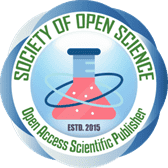Effect of Heavy Metal Pollution on Survival and Protein Changes in Liver and Intestine of Fresh Water Fish Tilapia mossambica
Keywords:
Pollution, Heavy Metal, Tilapia mossambica, ToxicityAbstract
The heavy metal salts constitute a very serious type of pollution because they are stable compounds and are not readily removed by oxidation, participations or other means and affect the activity of animals. The toxicity of Hg, Cd, Zn and their compound to fish has received the attention of a number of workers in recent years. In the present study, it is observed that contents of protein decreased gradually with an increase in concentrations of metals and damage of respiratory surface.
Downloads
References
Adam, M.S. & Abdel-Basset, R. (1990). Effect of lead nitrate and lead acetate on the growth and some metabolic processes of Scenedesmus obliquus. Acta Hydrobiologica, 32: 93-99.
Al-Bairuty, G.A., Shaw, B.J., Handy, R.D. & Henry, T.B. (2013). Histopathological effects of waterborne copper nanoparticles and copper sulphate on the organs of rainbow trout (Oncorhynchus mykiss). Aquat. Toxicol., 126: 104–115. https://doi.org/10.1016/j.aquatox.2012.10.005.
Allen, P. (1995). Soft-tissue accumulation of lead in the blue tilapia, Oreochromis aureus (Steindachner), and the modifying effects of cadmium and mercury. Biol. Trace Elem. Res., 50(3): 193–208. https://doi.org/10.1007/BF02785410.
Ciji, P.P. & Bijoy Nandan, S. (2014). Toxicity of copper and zinc to Puntius parrah (Day, 1865). Mar. Environ. Res., 93: 38–46. https://doi.org/10.1016/j.marenvres.2013.11.006.
Diwan, A.D., Hingorani, H.G. & Naidu, N.C. (1979). Levels of blood glucose and tissue glycogen in two live fish exposed to industrial effluent. Bull. Environ. Contam. Toxicol., 21(1-2): 269–272. https://doi.org/10.1007/BF01685422.
Dokholyan, V.K. & Akhmedova, T.P. (1978). Effect of mercury dichloride on some biochemical indexes of the brain, blood and liver of Rutilus rutilis Capicus. Vopr. Ikhtiol., 18: 177–180.
Eisler, R. (1973). Annotated bibliography on biological effects of metals in aquatic environments (No. 1-567). U.S. Environmental Protection Agency Report EPA-R3-73-007. pp. 287.
Hameed, S.V.S.A. & Muthu Kumaravel, K. (2006). Impact of cadmiun on the biochemical constituents of freshwater fish Oreochromis mossambicus. Indian J. Environ. Sci., 10(1): 63-65.
Hodson, P.V. (1976). Temperature Effects on Lactate–Glycogen Metabolism in Zinc-Intoxicated Rainbow Trout (Salmo gairdneri). J. Fish. Res. Board Can., 33(6): 1393-1397. https://doi.org/10.1139/f76-181.
Litchfield Jr, J.T. & Wilcoxon, F. (1949). A simplified method of evaluating dose-effect experiments. J. Pharmacol. Exp. Ther., 96(2): 99–113.
Lowry, O.H., Rosebrough, N.J., Farr, A.L. & Randall, R.J. (1951). Protein measurement with the Folin phenol reagent. J. Biol. Chem., 193(1): 265–275.
Meenakshi, V. & Pugazhendhy, K. (1998). Toxicity of mercuric chloride to the fingerlings of freshwater fish Cyprinus carpio (Linn). Uttar Pradesh J. Zool., 18(3): 145-148.
Nagabhushanam, R. & Kulkarni, G.K. (1981). Freshwater palaemonid prawn “Macro bacterium Kistnensis” effect of heavy metal pollutants. Proc. Indian Natl. Acad. Sci. B., 47: 389-396.
Oser, B.L. (1965). Hawk's Physiological Chemistry. 14th Ed., Tata McGraw-Hill Publ., New Delhi.
Palanivelu, P., Vijayavel, K., Ezhilarasi Balasubramanian, S., Balasubramanian, M.P. (2004). Combined effect of cartap hydrochloride and urea on biochemical constituents of freshwater fish Oreochromicus mossambicus. Journal of Ecotoxicology and Environmental Monitoring, 14(1): 23-29.
Paul, N., Chakraborty, S. & Sengupta, M. (2014). Lead toxicity on non-specific immune mechanisms of freshwater fish Channa punctatus. Aquat. Toxicol., 152: 105–112. https://doi.org/10.1016/j.aquatox.2014.03.017.
Qayyum, M.A. & Shaffi, S.A. (1977). Changes in tissue glycogen of a fresh water catfish Heteropneustes fossilis (Bloch) due to mercury intoxication. Curr. Sci., 46: 652–653.
Rajeshkumar, S. & Munuswamy, N. (2011). Impact of metals on histopathology and expression of HSP 70 in different tissues of Milk fish (Chanos chanos) of Kaattuppalli Island, South East Coast, India. Chemosphere, 83(4): 415–421. https://doi.org/10.1016/j.chemosphere.2010.12.086.
Sastry, K.V., Gupta, P.K. & Malik, P.V. (1979). A comparative study of the effect of acute and chronic mercuric chloride treatment on the activities of a few digestive enzymes of a teleost fish, Channa punctatus. Bull. Environ. Contam. Toxicol., 22(1): 28–34. https://doi.org/10.1007/BF02026902.
Sastry, K.V. & Rao, D.R. (1981). Enzymological and biochemical changes produced by mercuric chloride in a teleost fish, Channa punctatus. Toxicol. Lett., 9(4): 321–326. https://doi.org/10.1016/0378-4274(81)90004-7.
Sastry, K.V. & Gupta, P.K. (1978). Effect of mercuric chloride on the digestive system of a teleost fish, Channa punctatus. Bull. Environ. Contam. Toxicol., 20(3): 353–360. https://doi.org/10.1007/BF01683532.
Veena, K.B., Radhakrishnan, C.K. & Chacko, J. (1997). Heavy metal induced biochemical effects in an estuarine teleost. Indian J. Mar. Sci., 26: 74-78.
Downloads
Published
How to Cite
Issue
Section
License
Copyright (c) 2015 The author(s) retains the copyright of this article.

This work is licensed under a Creative Commons Attribution 4.0 International License.
This is an open access article distributed under the Creative Commons Attribution License which permits unrestricted use, distribution, and reproduction in any medium, provided the original work is properly cited.





